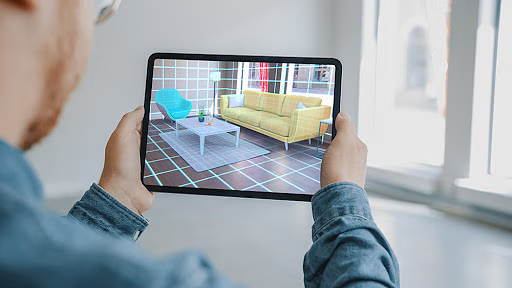Augmented Reality (AR) has transformed how we see and interact with digital information by superimposing virtual features on the actual world. AR applications have spread across industries, including gaming, education, retail, and healthcare, providing immersive experiences that combine virtual material with the physical surroundings. In this post, we look at the features, benefits, and emerging trends of augmented reality apps.
Understanding Augmented Reality
Augmented Reality improves the real-world environment by superimposing computer-generated images, movies, or information over the user’s view of the actual world. Unlike Virtual Reality (VR), which provides fully immersive digital settings, Augmented Reality (AR) enhances real-world experiences by adding layers of digital content that users may interact with via smartphones, tablets, smart glasses, or other AR-capable devices.
Applications for Augmented Reality Apps
1. Games
AR has had a big impact on the game industry by bringing virtual aspects into real-world environments. Apps like Pokémon GO popularized augmented reality gaming by allowing players to hunt for virtual monsters overlaid on their surroundings using GPS and camera technology. These games promote outdoor exploration and social engagement, combining physical activity with digital enjoyment.
2. Retail and Marketing
AR apps are revolutionizing the retail experience by allowing customers to virtually try on things like clothing, accessories, and furniture. Retailers use augmented reality to build interactive catalogs that enable shoppers to see how things will look in their area before making a purchase. This technology improves client engagement, decreases returns, and offers a more personalized purchasing experience.
3. Education and training
In education, AR apps improve learning experiences by making abstract concepts physical and engaging. AR-enabled textbooks, instructional games, and simulations enable students to explore historical locations, dissect virtual species, and study languages in an immersive environment. AR also aids professional training by mimicking real-world circumstances in medical, military, and industrial settings.
4. Healthcare
AR apps are transforming healthcare by boosting diagnosis accuracy, surgery planning, and patient outcomes. Surgeons utilize augmented Reality to visualize medical imaging data overlaid on a patient’s body during surgeries, improving precision and lowering risks. AR therapy apps use interactive exercises and immersive experiences to help patients with physical rehabilitation, pain management, and mental health issues.
5. Navigation and tourism
AR navigation apps improve travel experiences by overlaying real-time information onto maps or landmarks. Tourists can use augmented reality to acquire historical information, directions, and points of interest when touring new places. AR-based navigation is especially useful for indoor navigation in major venues such as airports, museums, and shopping malls, boosting accessibility and visitor experience.
Benefits of Augmented Reality Apps
1. Increased User Engagement
AR apps fascinate users by providing dynamic and personalized experiences that combine digital material and real-world settings. This engagement promotes deeper connections with companies, educational content, and entertainment media, resulting in higher user retention and satisfaction.
2. Enhanced Visualization and Understanding
AR increases visualizations by superimposing contextual information, 3D models, and animations on tangible things. This skill improves comprehension of complex data, spatial relationships, and abstract concepts, making learning and problem-solving more accessible and intuitive.
3. Empowered Businesses
Businesses can use AR apps to improve marketing, customer engagement, and operational efficiency. Companies may differentiate their offers, improve procedures, and increase productivity by using augmented Reality for virtual product demos, immersive advertising campaigns, and employee training.
Emerging Trends in Augmented Reality Applications
1. Integration with AI and IoT
AR apps are increasingly integrating with AI and IoT devices to provide smarter, more context-aware experiences. AI technologies improve object recognition, gesture detection, and real-time data processing in AR applications, while IoT connectivity allows for seamless interaction between physical and digital surroundings.
2. Spatial Computing
Spatial computing technologies, such as depth-sensing cameras and spatial mapping, improve AR applications by precisely putting virtual items in real-world environments. This innovation allows for more realistic and immersive AR experiences, which improves user interaction and environmental integration.
3. AR Cloud
The creation of AR Cloud architecture allows for persistent, shared AR experiences across various devices and locales. AR Cloud technology saves and synchronizes spatial data, allowing users to interact with virtual material that lasts over time and can be accessed from several perspectives and devices.
Final Words
Augmented Reality apps continue to change the way we engage with digital material and the physical environment, providing creative solutions in areas such as gaming, retail, education, healthcare, and tourism. As AR technology advances with advances in AI, IoT, and spatial computing, the potential for immersive, tailored experiences expands tremendously.
In conclusion, the widespread use of augmented reality apps demonstrates their transformational impact on user engagement, learning, corporate processes, and daily experiences. AR apps, whether they enhance entertainment, ease hard activities, or improve accessibility, have the potential to alter the future of digital engagement and redefine our experience of Reality.
